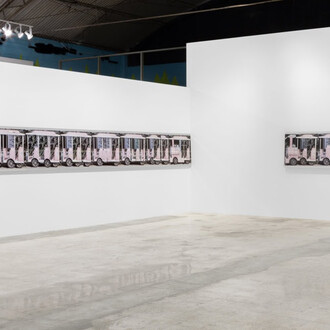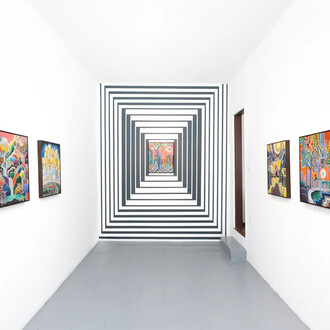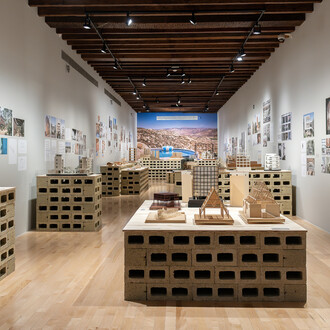Jorge Méndez Blake (Guadalajara, 1974) is an artist who uses various media, including drawing, painting, video, sculpture, installation, and performance, to explore the connections between significant literary works and space. Through his speculative engagement with authors and books, Méndez Blake explores the poetic potential of objects and actions and what they reveal about plot.
Gonzalo Lebrija (Ciudad de México, 1972) primarily studies time and our subjective experience of it. Using video and photography as recording systems, Lebrija captures ephemeral moments by using time as raw material, while stretching the distance between the past and the future to investigate the concepts of destiny and chaos.
Milena Muzquiz (Tijuana, 1972) creates works of expressive rotundity through her contemplation of nature, which she expresses by directly using her body and hands with clay. Whether she uses ceramics or painting, her works reveal certain epic gestures and a childlike innocence referencing traditional disciplines, as well as a primitivism framing a space of timeless freedom. Each piece is part of a larger, chaotic, and eclectic narrative that constitutes her imagination.
Ana Prata (Sete Lagoas, 1980) works with latent ambiguity, walking the line between humor, introspection, and a critical spirit. Her colorful, figurative paintings recently depict still lifes of fruit and objects that appear to be cut from the landscape. This interior landscape is barely insinuated, as it is not used as a source of reality or context. On the contrary, it confronts us with a lyrical and symbolic dialogue with the domestic.
Tania Pérez Córdova (Ciudad de México, 1979) is a sculptor whose work explores temporality and the useful life of objects. She conceives of her work as “situations” and creates sculptures and installations that consider the contextual relationships of everyday objects. She works with a wide range of materials and incorporates found objects and performance through networks of intimate and interpersonal exchanges. Her interest in everyday events highlights how seemingly insignificant situations are linked to the infrastructure of our social and economic reality and the complexity of the contemporary world.
Donna Huanca (Chicago, 1980) challenges the male gaze by exploring feminine and indigenous, particularly Andean, narratives and markings. Her installations, which encompass painting, sculpture, and live performance, are created for and integrated into the architectural spaces in which they are presented. Her art is deeply tied to ritual practices of Andean culture and the concept of ritual as a means of transcendence, meditation, and transformation.
Manuela Solano (Ciudad de México, 1987) has an artistic practice that is influenced by her personal experiences. The characters and settings in her work reflect her interests, desires, and insecurities. She lost her sight at the age of 26 due to medical negligence in her HIV treatment. This irreparable loss of sight led the artist to develop a method that allowed her to paint again. She had to let go of her perfectionism and embrace the challenge of exploring color and figuration.
John Isaacs (Edimburgo, 1968) has worked with a wide range of materials—including wax, fabric, bronze, neon, ceramics, painting, collage, glass, and photography—for over fifteen years. He uses these materials to explore the complexity of inhabiting the modern world, the paradoxes of everyday life, and human identity. His works are often grotesque yet fascinating and technically perfect critiques of our society and its wastefulness, extravagance, consumerism, and pollution.
Charlie Billingham (Londres, 1984) uses cut-out sections of satirical illustrations and prints from the Georgian and Regency periods as the basis for his paintings. Through cutting and recomposing, he strips the original illustrations of their narrative content, isolating specific moments, gestures, and expressions to form new compositions. He often arranges the canvases on hand-painted walls with prints based on his watercolors.
Teresa Solar Abboud (Madrid, 1985) starts from an imaginary based on the morphology of speech and, by extension, of thought. Concepts such as resistance, isolation, connectivity and immunity are developed in a multidisciplinary production centered on sculpture and drawing and based on the creation of multilayered narratives. His is a practice full of words and full of organs that create words: a loquacious work that doubts itself but nevertheless wants to speak.












